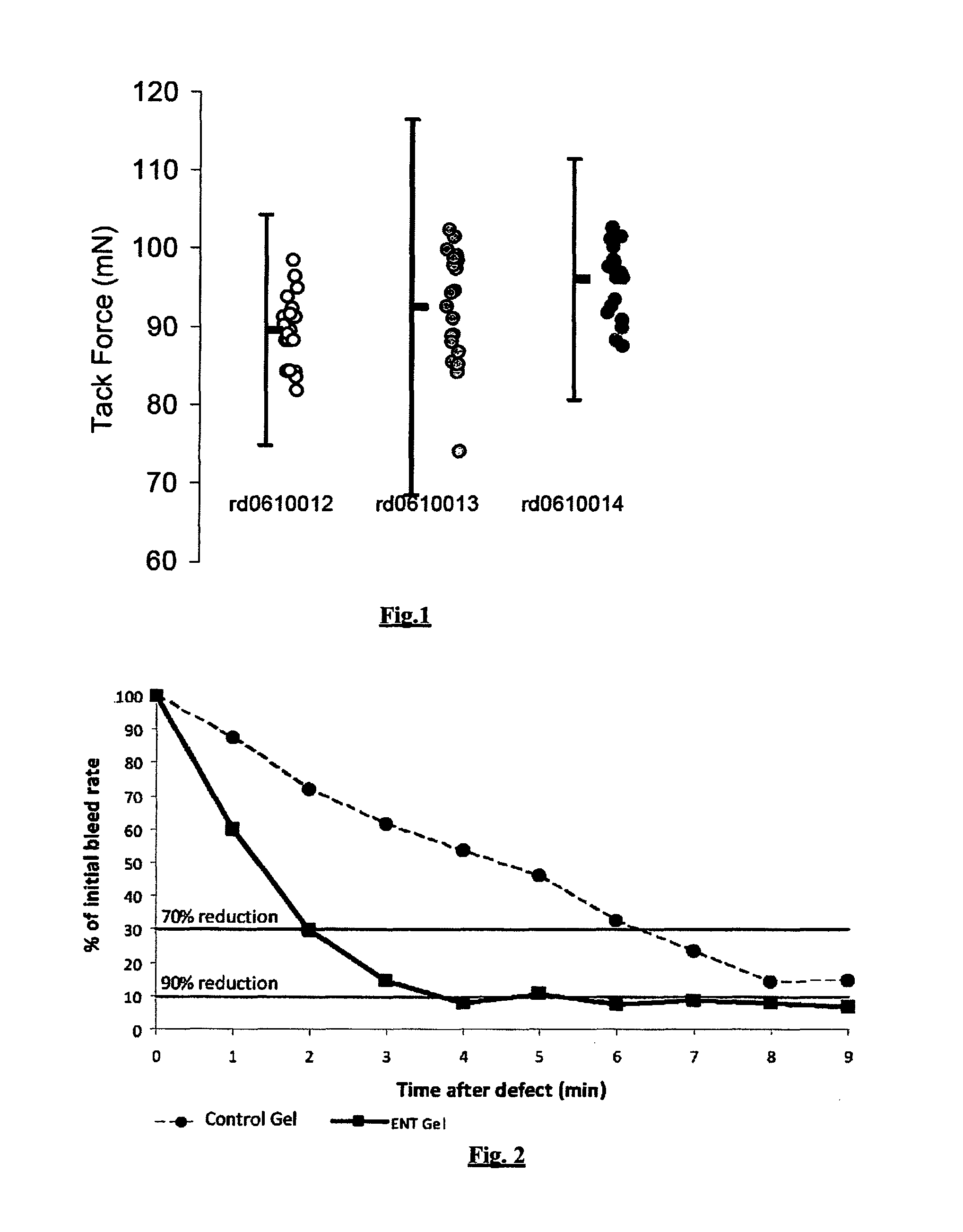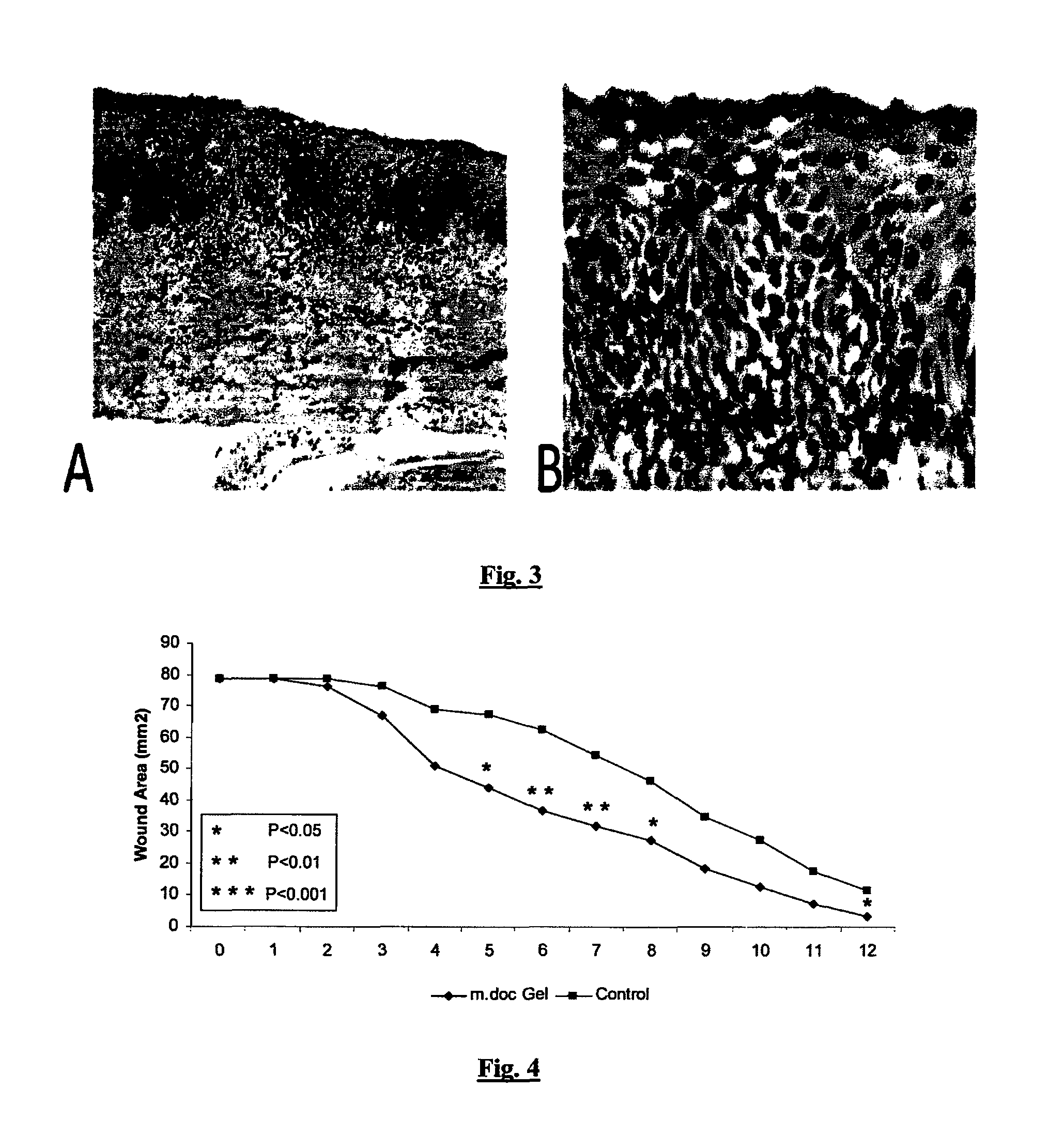Surgical gel system
a gel system and gel technology, applied in the field of surgical gel systems, can solve the problems of inability to undertake particular types of surgery, limited surgical field, and inability to perform surgery
- Summary
- Abstract
- Description
- Claims
- Application Information
AI Technical Summary
Benefits of technology
Problems solved by technology
Method used
Image
Examples
example 1
Sterile Haemostatic Gel
[0068]A gel was prepared with the following composition.
[0069]
Formulation(% (w / w) finalIngredientsformulation)Calcium-sodium polyanhydroglucuronic9acidPectin4Potassium sorbate0.2Gylcerin3dH2O78.8Ethanol5
[0070]The viscosity of the prepared gel was 617,000 cP at 37 degrees C. (Brookfield DV-II+ PRO Digital Viscometer, LV-4 spindle, 0.3 RPM).
[0071]The gel is sterilised by gamma irradiation between 4 and 45 kGy, sufficient to produce a sterility assurance limit (SAL) of 10−6. Alternatively, material may be processed aseptically from materials to produce a material with a sterility assurance limit (SAL) of 10−6.
[0072]The viscosity of the sterilised gel was 311,000 cP at 37 degrees C. (Brookfield DVII+ PRO Digital Viscometer, LV-4 spindle, 0.3 RPM)
[0073]The viscosity of the material is suitable for dispensing through a nozzle or small office to the site of bleeding. The dispensing apparatus could be a syringe, a tube or any such similar device. In this example the g...
example 2
Sterile Haemostatic Gel
[0074]A gel was prepared with the following composition.
[0075]
Formulation(% (w / w) finalIngredientsformulation)Calcium-sodium polyanhydroglucuronic9.0acidPectin3.6Potassium sorbate0.2Gylcerol2.9Deionised H2O79.2Ethanol5.1
[0076]The viscosity of the prepared gel was 607,000 cP at 37 degrees C. (Brookfield DV-II+ PRO Digital Viscometer, LV-4 spindle, 0.3 RPM).
[0077]The gel is sterilized by gamma irradiation between 4 and 45 kGy, sufficient to produce a sterility assurance limit (SAL) of 10−6. Alternatively, material may be processed aseptically from materials to produce a material with a sterility assurance limit (SAL) of 10−6.
[0078]The viscosity of the sterilised gel was 250,000 cP at 37 degrees C. (Brookfield DVII+ PRO Digital Viscometer, LV-4 spindle, 0.3 RPM)
[0079]The viscosity of the material is suitable for dispensing through a nozzle or small orfice to the site of bleeding. The dispensing apparatus could be a syringe, a tube or any such similar device. In t...
example 3
Use of Sterile Haemostatic Gel in Swine Nasal Mucosal Laceration Injuries
[0083]The haemostatic gel of example 1 was applied to swine nasal mucosa laceration injuries with bleeding rates between 3 to 25 mL / min and successful hemostasis was achieved. A commercially available nasal dressing and sinus stent hydrogel composed of cross-linked hyaluronic acid was used as a control gel. Application of the calcium-sodium microdispersed polyanhydroglucuronic acid containing gel coated the surface of the injury, facilitates interaction between the bleeding site and the microdispersed oxidized cellulose (FIG. 2). 70% reduction in bleeding was achieved within 1.5 minutes and with 90% reduction in bleeding in as little as 3 minutes. The gel was adherent and coated vertical and inverted tissue surfaces. The control gel only achieved 70% reduction in bleeding after approximately 6 minutes and did not achieve 90% reduction in bleeding in the course of the study. This swine study demonstrated success...
PUM
| Property | Measurement | Unit |
|---|---|---|
| viscosity | aaaaa | aaaaa |
| viscosity | aaaaa | aaaaa |
| viscosity | aaaaa | aaaaa |
Abstract
Description
Claims
Application Information
 Login to View More
Login to View More - R&D
- Intellectual Property
- Life Sciences
- Materials
- Tech Scout
- Unparalleled Data Quality
- Higher Quality Content
- 60% Fewer Hallucinations
Browse by: Latest US Patents, China's latest patents, Technical Efficacy Thesaurus, Application Domain, Technology Topic, Popular Technical Reports.
© 2025 PatSnap. All rights reserved.Legal|Privacy policy|Modern Slavery Act Transparency Statement|Sitemap|About US| Contact US: help@patsnap.com


